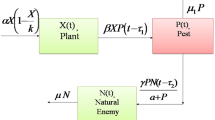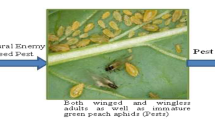Abstract
In this study, a three species plant-pest-natural enemy compartmental model incorporating gestation delays for both pests and natural enemies in a polluted environment is proposed. The boundedness and positivity properties of the model are established. Equilibria and their stability analysis are carried out for all possible steady states. The existence of Hopf bifurcation in the system is analyzed. It is established that the natural enemy free steady state \(E_2\) is stable for specific threshold parameter values \(\tau _1\in (0,\tau _{10}^+)\), i.e., gestation delay for pest species belongs to zero and it’s own critical value, \(\tau _{10}^+\) and the coexisting steady state \(E^*\) is stable for specific threshold parameter values \(\tau _1\in (0,\tau _{10}^+)\) and \(\tau _2\in (0,\tau _{20}^+)\), i.e., gestation delay for pest species belongs to zero and it’s own critical value, \(\tau _{10}^+\) and gestation delay for natural enemies belongs to zero and it’s own critical value, \(\tau _{20}^+\). If both gestation delays for pest and natural enemies, i.e., \(\tau _1, \tau _2\) respectively cross their threshold parameter values, i.e., \(\tau _1>\tau _{10}^{+},\tau _2>\tau _{20}^{+}\), then the system perceived oscillating behavior and Hopf bifurcation occurs in the system. The sensitivity analysis of the system at interior steady state is presented and the sensitive indices of the variables are identified. Finally, simulations are performed to support our analytic results with a distinct set of parametric values.









Similar content being viewed by others
References
Thomas, M.B., Willis, A.J.: Biocontrol-risky but necessarys. Trends Ecol. Evol. 13, 325–329 (1998)
Parrella, M.P., Heinz, K.M., Nunney, L.: Biological control through augmentative releases of natural enemies: a strategy whose time has come. Am. Entomol. 38(3), 172–179 (1992)
Kishimba, M., Henry, L., Mwevura, H., Mmochi, A., Mihale, M., Hellar, H.: The status of pesticide pollution in Tanzania. Talanta 64(1), 48–53 (2004)
Weaver, R.D., Evans, D.J., Luloff, A.E.: Pesticide use in tomato production: consumer concerns and willingness-to-pay. Agribusiness 8(2), 131–142 (1992)
Jain, P.C., Bhargava, M.C.: Entomology: Novel Approaches. New India Publishing Agency, New Delhi (2007)
Kar, T.K., Ghosh, B.: Sustainability and optimal control of an exploited prey predator system through provision of alternative food to predator. BioSystems 109, 220–232 (2012)
Ghosh, B., Grogrnard, F., Mailleret, L.: Natural enemies deployment in patchy environments for augmentative biological control. Appl. Math. Comput. 266, 982–999 (2015)
Kumar, V., Dhar, J., Singh, H., Bhatti, H.S.: Plant pest natural enemy dynamics with disease in pest and gestation delay for natural enemy. J. Math. Comput. Sci. 5(7), 948–965 (2017)
Kumar, V., Dhar, J., Bhatti, H.S.: Stability and Hopf-bifurcation dynamics of a food chain system: plant-pest-natural enemy with dual gestation delay as a biological control strategy 4(2), 881–889 (2018)
Lian, F., Xu, Y.: Hopf bifurcation analysis of a predator–prey system with Holling type IV functional response and time delay. Appl. Math. Comput. 215(4), 1484–1495 (2009)
Liu, X., Han, M.: Chaos and Hopf bifurcation analysis for a two species predator–prey system with prey refuge and diffusion. Nonlinear Anal. Real World Appl. 12(2), 1047–1061 (2011)
Singh, H., Dhar, J., Bhatti, H.S.: Dynamics of a prey generalized predator system with disease in prey and gestation delay for predator. Model. Earth Syst. Environ. 2(2), 52 (2016)
Song, Y., Wei, J.: Local Hopf bifurcation and global periodic solutions in a delayed predator–prey system. J. Math. Anal. Appl. 301(1), 1–21 (2005)
Zhao, H., Lin, Y.: Hopf bifurcation in a partial dependent predator–prey system with delay. Chaos Solitons Fractals 42(2), 896–900 (2009)
Faria, T.: Stability and bifurcation for a delayed predator–prey model and the effect of diffusion. J. Math. Anal. Appl. 254(2), 433–463 (2001)
Li, K., Wei, J.: Stability and Hopf bifurcation analysis of a prey–predator system with two delays. Chaos Solitons Fractals 42(5), 2606–2613 (2009)
Song, Y., Peng, Y., Wei, J.: Bifurcations for a predator–prey system with two delays. J. Math. Anal. Appl. 337(1), 466–479 (2008)
Xu, C., Liao, M., He, X.: Stability and Hopf bifurcation analysis for a Lotka–Volterra predator–prey model with two delays. Int. J. Appl. Math. Comput. Sci. 21(1), 97–107 (2011)
Aiello, W., Freedman, H.: A time-delay model of single-species growth with stagestructure. Math. Biosci. 101(2), 139–153 (1990)
Magniusson, k: Destabilizing effect of cannibalism on a structured predator–prey system. Math. Biosci. 155(1), 61–75 (1999)
Wang, W., Chen, L.: A predator–prey system with stage-structure for predator. Comput. Math. Appl. 33(8), 83–91 (1997)
Xu, R., Chaplain, M., Davidson, F.: Global stability of a Lotka–Volterra type predator–prey model with stage-structure and time delay. Appl. Math. Comput. 159(3), 863–880 (2004)
Zhang, X., Chen, L., Neumann, A.: The stage-structured predator–prey model and optimal harvesting policy. Math. Biosci. 168(2), 201–210 (2000)
Alakes, M., Rita, P., Shariful, A.: A ratio-dependent predator–prey model with strong allee effect in the prey and an alternative food source for the predator. Int. J. Res. Eng. Technol. (2016)
Hu, H., Huang, L.: Stability and Hopf bifurcation in a delayed predator–prey system with stage-structure for prey. Nonlinear Anal. Real World Appl. 11(4), 2757–2769 (2010)
Huang, C., Zhao, M., Zhao, L.: Permanence of periodic predator–prey system with two predators and stage-structure for prey. Nonlinear Anal. Real World Appl. 11(1), 503–514 (2010)
Zhang, H., Jiao, J., Chen, J.: Pest management through continuous and impulsive control strategies. Biosystems 90(2), 350–361 (2007)
Zhang, J., Jin, Z., Yan, J., Sun, G.: Stability and Hopf bifurcation in a delayed competition system. Nonlinear Anal. Theory Methods Appl. 70(2), 658–670 (2009)
Shigui, R.: Absolute stability, conditional stability and bifurcation in Kolmogorov-type predator–prey systems with discrete delays. Q. Appl. Math. 59(1), 159–174 (2001)
Acknowledgements
The authors would wish to thank the referee and reviewer for their valuable advice on improving the presentation of the paper. Also, authors would want to thank, I. K. Gujral Punjab Technical University, Jalandhar-Kapurthala-144601, Punjab, India for providing the opportunity to pursue the research.
Author information
Authors and Affiliations
Corresponding author
Ethics declarations
Conflict of interest
The authors declare that they have no conflict of interest. There is no funding source available and this study is involved human participants only.
Additional information
Publisher's Note
Springer Nature remains neutral with regard to jurisdictional claims in published maps and institutional affiliations.
Rights and permissions
About this article
Cite this article
Kumar, V., Dhar, J. & Bhatti, H.S. Bifurcation dynamics of a plant-pest-natural enemy system in polluted environment incorporating gestation delays. Ricerche mat 69, 533–551 (2020). https://doi.org/10.1007/s11587-019-00455-x
Received:
Revised:
Published:
Issue Date:
DOI: https://doi.org/10.1007/s11587-019-00455-x
Keywords
- Plant-pest-natural enemy
- Polluted environment
- Equilibria
- Gestation delay
- Boundedness
- Positivity
- Hopf bifurcation
- Sensitivity analysis




